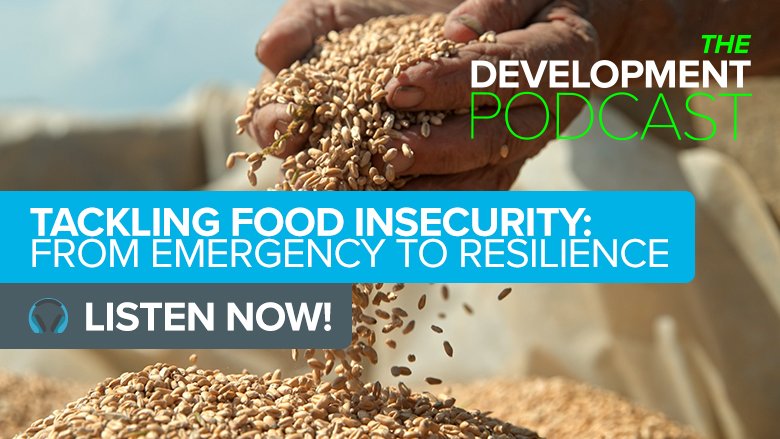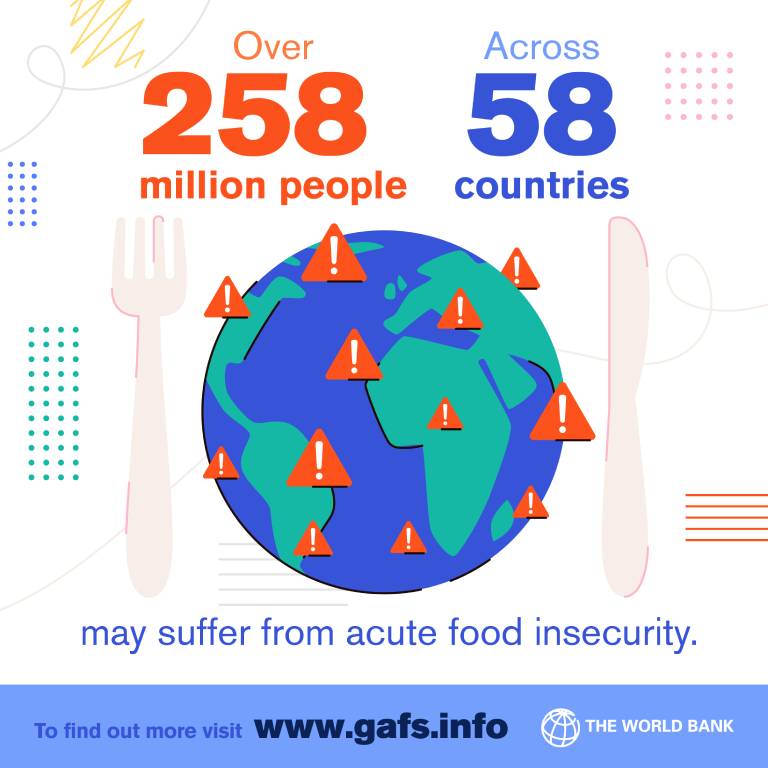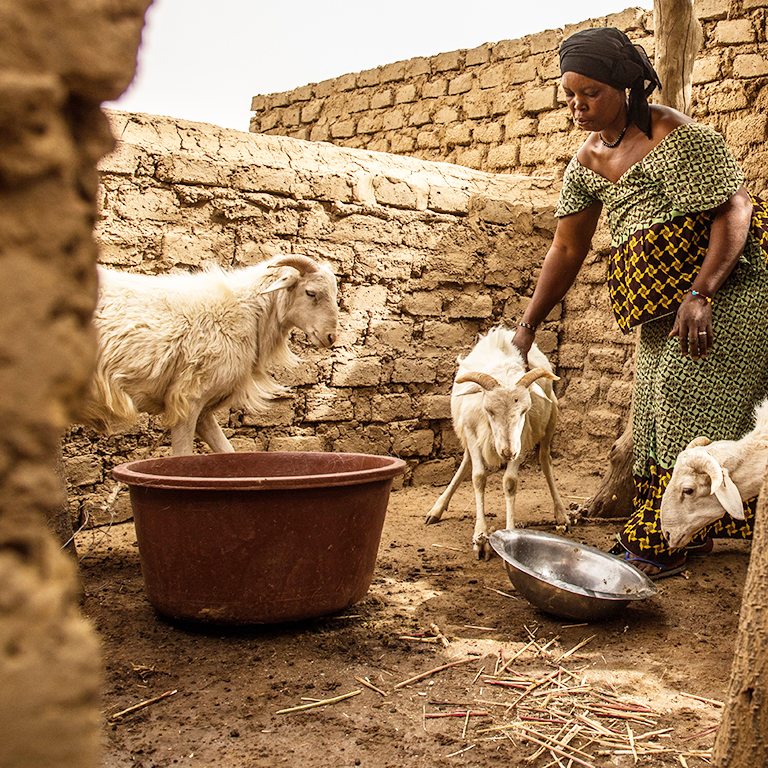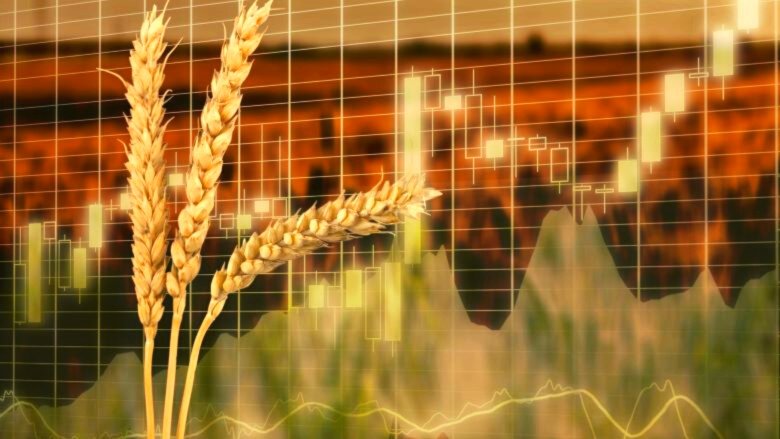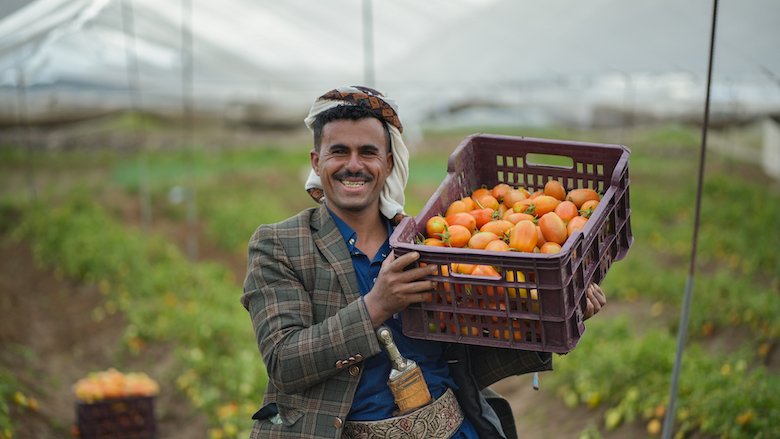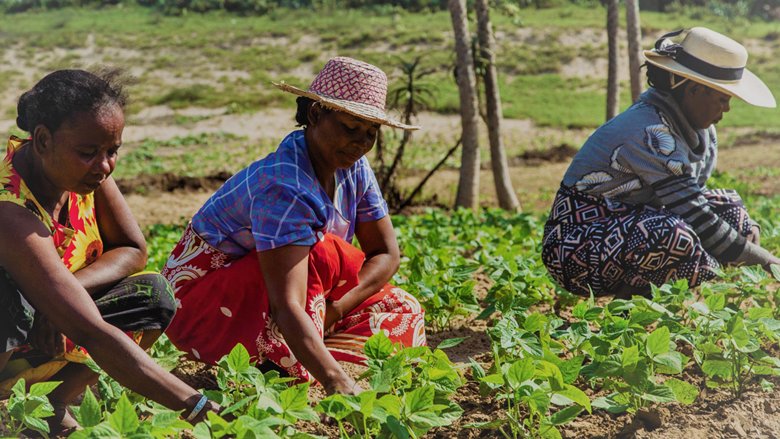Multiple shocks – from COVID-19 to climate change, conflict, crop disease – are crippling food systems, leading to higher food prices and growing hunger. Up to 783 million people faced hunger in 2022, and projections show that in 2030, over 600 million people will still struggle to feed their families. The way we produce food is also harmful for the planet, generating unsustainable levels of pollution and waste.
What can we do to fight the global food crisis, especially in the most vulnerable regions? What are the World Bank and its partners doing to address this issue and what solutions have worked on the ground?
To answer these questions, on this episode of The Development Podcast we speak to: Gladys Wanja, a Kenyan mother and entrepreneur on the struggles she faces putting food on the table; Valerie Guarnieri, the World Food Programme’s Assistant Executive Director for Programme and Policy Development on how the Nobel-prize winning organization responds to dire emergencies; Dr. Catherine Nakalembe, NASA Harvest’s Africa Program Director and Assistant Professor at the University of Maryland on solutions in space technology, and Martien van Nieuwkoop, the World Bank’s Global Director for Agriculture and Food on what the Bank is doing to address the food crisis.
Tell us what you think of our podcast here >>>. We would love to hear from you!
Featured Voices
- Martien van Nieuwkoop, the World Bank’s Global Director for the Agriculture and Food Global Practice
- Valerie Guarnieri, the World Food Program’s Assistant Executive for Programme Director and Policy Development
- Dr. Catherine Nakalembe, NASA Harvest’s Africa Program Director and Assistant Professor at the University of Maryland
- Gladys Wanja, a Kenyan mother and small business owner
Transcript
[00:00] Srimathi Sridhar: Hello and welcome to The Development Podcast from the World Bank, coming to you from Washington DC and beyond. I'm Srimathi Sridhar. Coming up in this month's episode, why food insecurity is an ongoing cause for concern and what can be done to tackle it. In many parts of the world, rising food prices are making even daily staples like rice and bread inaccessible. Food price volatility is compounded by the impacts of climate change and supply chain insecurity caused by conflict. Yet, as the world's population grows, the demand for food is only increasing. We'll hear about the choices families have to make when prices rise.
Gladys Wanja: Buying food has really become a serious problem.
Srimathi Sridhar: We'll also be hearing about emergency and resilience and how the World Food Program is responding to the challenge of rising hunger.
Valerie Guarnieri: We're never going to get on top of the needs by just responding and providing emergency assistance. We need to be looking at how we can invest in resilience and reduce those needs over time.
Srimathi Sridhar: We look at innovative solutions, how satellite technology is helping fight droughts, and we'll also hear what the World Bank is doing to address the food crisis globally.
Martien van Nieuwkoop: I think to build long-term resilience, we really need to transform our food system. So how we produce, distribute and consume food. There's no food security without food systems transformation.
[01:46] Srimathi Sridhar: That's all coming up in the Development Podcast. Food security. It's not a simple topic and there isn't a country in the world where food security isn't an issue. So, let's take a look at what it means. The definition of food security is that all people at all times have access, economic and physical, to enough safe and nutritious food to meet their dietary needs, their preferences, and to lead an active and healthy life. There are some complexities, but essentially that's a definition, and the world is currently in a food crisis.
News archive: These families have trekked for days across a hostile wilderness in search of food. Tens of thousands have made similar journeys in recent weeks. The baby is really very severely malnourished.
Srimathi Sridhar: As those clips from news reports over the last couple of years explain, a lot of people are going hungry and some parts of the world are disproportionately impacted. There are predictions that over 600 million people will still face hunger by 2030. Climate change, biodiversity loss, conflict, and other economic pressures pushing up inflation over the last year have meant that for many people, food has become a bigger part of their budget. Our producer, Sarah Treanor, found out more.
[03:02] Sarah Treanor: The chatter of children in Murang'a County, Kenya, returning home from school, looking forward to their evening meal. But for many parents, food price volatility means that providing that meal has become harder.
Gladys Wanja: Hello, my name is Gladys Wanja. About this topic of food prices going up in Kenya. It has really been a serious problem.
Sarah Treanor: Gladys has two children. She runs a business and she grows food, but she says that she's found the last 18 months challenging and has had to make tougher choices when it comes to what she buys and what the family eats.
Gladys Wanja: You are buying whatever is very, very cheap regardless of the quality. Buying food has really become a serious problem. I'm even conscious when we are cooking at home. I want to check every evening when we remain food, I make sure we don't throw it away. We'll consume it the following day, either in the morning or during lunch hour. Initially, I never used to do that.
Sarah Treanor: So what has Gladys found to have become prohibitively expensive?
Gladys Wanja: The food that I have noted has really gone in prices is the serious. I think it's because we have had years of drought season following each other. There is also another issue of oil for cooking. I've been really conscious in buying oil, which is really high. I am really conscious of wastage nowadays. I don't want anything to be wasted because it is translating to money, which is really not easy to come by. Vegetables have also become really expensive. Bread is no longer a priority. We are actually trying to train our children to eat food that remained for supper in the morning.
Sarah Treanor: Gladys tells me that food prices have become a part of everyday conversation.
Gladys Wanja: People are really talking about all the time. Whenever you go out there, people are talking about food availability. So it's a serious concern.
Sarah Treanor: Gladys says that some people are starting to learn how to grow more of their own food and she says she thinks this will help in the longer term.
Gladys Wanja: I have noted that us who visit farmers, we are now getting a lot of recommendations to do the moving gardens, the ones you can put in your balcony to grow vegetables, the ones you can put around your rented house to grow vegetables. So people have become more of innovative. They're coming up with ways to at least do something that will save a healing to do something else.
[05:46] Srimathi Sridhar: Thanks, Sarah and to Gladys for speaking to us here on the Development Podcast. Let's shift now to the Central African Republic, a landlocked nation in the heart of Africa. It's also one of the poorest and most fragile countries in the world with high levels of food insecurity. According to the World Food Program, WFP for short, 45% of the population is food insecure. The Emergency Food Security Response Project, implemented by the World Bank, WFP and the Ministry of Agriculture provided seeds, farming tools and training to some 329,000 small holder farmers. The result? Increased local food production by 250% in less than a year. In a moment, we'll hear from WFP. But first a word from Tatiana Kamada, one of the farmers able to boost food production.
Tatiana Kamada: Thanks to my work in the field, my life and my children's life have changed. Before it was hard finding food for my family. That's why I work as a farmer. I sell some of the crops in the market and keep what's left to feed my children. Since then, life has been better for us because now we can afford to eat breakfast in the morning.
[07:09] Srimathi Sridhar: Valerie Guarnieri, the World Food Program's assistant executive director for program and policy development spoke to me from her offices in Rome.
Valerie Guarnieri: So last year in 2022, WFP reached 158 million people with emergency lifesaving food and cash assistance. We also supported people with school meals so that school children could get a nutritious meal in school, mothers and children with nutrition services, small holder farmers with efforts to boost their resilience in the face of recurring shocks. This year, what we're finding is a situation where hunger is continuing to rise. 345 million people facing acute hunger this year, but resources are shrinking. So that creates a tremendous problem where we have to be reducing our operations, cutting the number of people who we're assisting and doing that at the very moment when we should be scaling up further to reach more people. So it's a very tough year.
[08:19] Srimathi Sridhar: Now, what would you say are the impacts of famine and hunger beyond malnutrition on countries and also communities?
Valerie Guarnieri: Hunger and malnutrition really work hand in hand and really create this spiraling impact on people's wellbeing. And we see that in terms of each of the drivers of hunger. We talk about conflict, natural hazards and economic shocks driving hunger, but there's also a feedback loop in play where these same factors are impacted by hunger. And when you look at the economic impact of hunger and malnutrition, hungry people, malnourished populations, you see a loss of productivity. You see an increase in illness, an increased occurrence of death. Undernourishment in and of itself reduces physical activity. It reduces cognitive activity and cognitive development, and also the ability of children to learn. So this has a direct impact on individuals, but also on communities and on nations in terms of lost productivity and lost income.
[09:30] Srimathi Sridhar: And Valerie, what about conflict? Can you unpack that a little bit more for us?
Valerie Guarnieri: We know that conflict is a driver of hunger. 70% of the acute hunger exists in countries that are facing conflict impacted by conflict, but conflict also drives displacement, which then generates more conflict. We see land and water access disputes happening when traditional pastor list migration routes come up against agrarian communities. We see rising food prices giving rise to riots and urban settings, and we saw that in 2008 with the high food prices in countries like Burkina Faso and Cameroon and Egypt and Haiti. So these inequities that already exist in the context of poverty and in many countries are exacerbated by situations of hunger and high food prices, and that then creates a spiraling impact.
[10:38] Srimathi Sridhar: A lot of these issues really seem to be intertwined. We're talking today about going beyond emergency to also building resilience when it comes to food security. What can the World Food Programme's experiences teach us here?
Valerie Guarnieri: How do we meet the urgent need in emergencies by ensuring that people have access to the most basic food and nutrition services that they need, but layering that with activities that try to reduce that hunger over time? And this is where resilience building really comes into play. And a great example of that is in the Sahel, a part of the world that struggles with lean seasons each year that for more than a decade, we've been trying to help governments fill with assistance provided to people who are impacted by those lean seasons. But over the past five years, we've been investing with communities in restoring degraded land, in small scale rural infrastructure that help rehabilitate or put in place small water systems, harnessing systems, irrigation systems, and linking that with, again, small scale efforts to ensure market roads are in place in order for produce that is grown to be delivered to market, but then also engaging in partnerships so that what is being grown is more nutritious and has more value in terms of value value crops. And in Niger, last year, after years of investing in this kind of work, we found 500,000 people in areas that we have been working in who did not require assistance even though they were in the areas that were heavily impacted by the drought and by food shortages because of what they were able to do by the increased resilience they have built. So we're never going to get on top of the needs by just responding and providing emergency assistance. We need to be looking at how we can invest in resilience and reduce those needs over time.
[12:48] Srimathi Sridhar: Valerie, I'd love to ask you a question on more of a personal note. What has inspired you or given you hope?
Valerie Guarnieri: I always take inspiration from really that deep resilience and the strength of communities that we work with, and particularly the women in those communities. I mean, we know that women do the majority of production in countries where we are working. They are, at the same time, doing childcare, trying to make it work with small businesses. And, I mean, I just am constantly amazed by the strength and resilience that they bring in. And for me, that's inspiring. We've just launched a new effort with cash transfers. Last year we delivered 3.3 billion dollars in cash transfers to people around the world. We want to put more of that cash in the hands of women and link the provision of cash transfers with efforts to address financial inclusion. And so investing in women is both the best bet, but it also gives me inspiration in the work that I do.
Srimathi Sridhar: Thanks again to Valerie. That was a really fascinating snapshot into the critical work of WFP. And before we move along, a quick reminder for those of you tuning in to take a look at our survey, which is linked on your podcast platform, and tell us what you think of the show. Hand in hand with the idea of building resilience, as Valerie was explaining, is data. And here technology is the new frontier.
[14:13] NASA archive: Main engine start. Two, one. Booster ignition and liftoff of Discovery. Celebrating its 25th birthday ...
Srimathi Sridhar: No, we aren't talking yet about growing crops on the moon, but how satellites and NASA partnerships are helping to change the way data is gathered and can be used. Let's hear from Dr. Catherine Nakalembe, an assistant professor at the University of Maryland's Department of Geographical Sciences and the director of NASA Harvest, Africa program.
Dr. Catherine Nakalembe: Since the 70s, we've had satellites observing the earth. With these satellites, we're able to get insights over really, really, really large landscapes. And so how do you translate the knowledge and information we have from these satellites outside of just quantifying cropland area across very, very large areas? How do you move from just these data sets into decision-making processes? And so NASA Harvest was started as sort of this concerted effort towards making the best available information accessible, but as well as useful in decision-making processes. So you might find that one country has a map, a cropland map, for example, from the year 2000 and we're in 2023, it might be 500 meter resolution. In that case, some of what we do is try to improve the availability or the quality of the dataset that's available because there's so much information out there, there's so many data sets. But the question is how do you move from a data set to a decision?
[15:52] Srimathi Sridhar: Can you give us an idea of how food security issues are manifesting in East Africa from the work that you've done on the ground in Uganda?
Dr. Catherine Nakalembe: In Uganda, in the past, we worked on this disaster risk financing program, which is a program between the Ugandan government and the World Bank. But basically it was how early can we tell that there's going to be a drought, and then if there will be a drought, they would scale up this public works part of this other Northern Uganda development project. If you look at East Africa more broadly, it's probably a net food exporter. We have enough, but it's not distributed equally. And in many cases it's things like infrastructure that make it impossible for food to be stored. And so Uganda has that sort of dynamic in the northeast of the country, it's very dry. Yet in the southwest of the country, can be wet and can produce a lot of food that can support even the north. But there's no infrastructure between the two places to be able to bring food to the northeast. And then if you go on the other side of the border, Kenya is an example of a country that has experienced basically one extreme after another in the last couple of years. I don't think there's been a very normal growing season in Kenya for the last probably six, seven years. Everything from complete crop failure in parts of the country. And then we have El Nino this year, for example, beginning and farmers are rushing to harvest their food. It's not for the lack of farmers trying to grow crops. It is a combination of not only environmental threats, but they also don't have access to things that can allow them either to produce more or bring things to markets or access things that are required for them to increase productivity.
[17:28] Srimathi Sridhar: What would you say is the next frontier for using satellite data for food systems?
Dr. Catherine Nakalembe: I think the frontier is proving its value. We can quantify so much, we can show so much, we can demonstrate, we can understand that if a drought is unfolding in place X, it's impacting this general area and we have some understanding of what production typically is in a normal year. So the shortfall is going to be this much. The demonstrating the value is actually translating that into impactful policy program. So in a case for the disaster risk financing program, it was basically, okay, there's going to be a drought. The drought happens, you determine how bad it's going to be, and then you make available alternative sources of income for the community to work on. That then they're able to purchase food. But what you want to do is scale those things, right? To a level where it's guaranteed that this kind of support will exist over the long-term, natural term projects, being able to move the value of the numbers and quantifying into actual policy actions.
Srimathi Sridhar: Well, thank you for all the work that you're doing in this space, Catherine, and for sharing some of that with us here today on The Development Podcast. It's been great having you.
Dr. Catherine Nakalembe: Well, thank you for having me. It was great chatting with you.
[18:54] Srimathi Sridhar: We've heard from WFP about its emergency programs, from Catherine about how satellites can help us be more responsive to extreme weather and resulting droughts, floods. But what about the longer term? Let's now cross to Egypt, where improved and expanded storage for grain is strengthening the country's preparedness and resilience to future shocks. Here's Ahmed Hussein Ibrahim, a manager at the Egyptian Holding Company for Silos in Storage.
Ahmed Hussein Ibrahim: Of course, the expansions meet to the size, will improve wheat storage capacity. The total storage capacity will be 100,000 tons, helping us to receive the largest amount of wheat from traders, farmers, public and private sectors. These size will protect us from wasted crops. The expansions will provide job opportunities and benefit the Egyptian citizen by securing food. We provide high quality wheat for mills. This will, of course, help in securing subsidized bread for Egyptians.
[20:00] Srimathi Sridhar: Let's get the view now from the World Bank. Martien van Nieuwkoop is Global Director for the Agriculture and Food Global Practice here at the World Bank. I asked Martien what's needed to ensure longer term food security and why resilience is so important.
Martien van Nieuwkoop: The world is really off track. I mean, to achieve the zero hunger SDG target by 2020/30. Also, the world population continues to grow, I mean, to 10 billion people by 2050. And, of course, we will be continuing to face a larger impacts from climate change, visual effect, world's agricultural sector and food production. Of course, also, the agriculture sector and food system contributes, I mean, to around one third of global greenhouse gas emissions. So it's both a victim and a culprit of climate change. I think to build long-term resilience, we really need to transform our food system, so how we produce, distribute and consume food. For that reason, we are saying that there's no food security without food systems transformation. Now, of course, each country needs to define its own pathways, but we see five important enablers, I mean, for food systems transformation that are relevant to all countries getting incentives right? So that includes the rethinking and repurposing agri-food policies. Right now, the world and governments around the world are providing about $800,000,000,000 in public support or agriculture. Most of it is not very effective. So really there's a huge opportunity actually to use those resources as a force for the good rather than generating hidden costs as it currently is doing. The second enabler is investments, particularly bringing in private sector investments in greening supply chain. The third enabler is we need to really accelerate innovation. Really, really critical, huge payoffs. But countries are under investing. The fourth enabler is making sure that we enhance data collection and analysis to better understand food systems and vulnerability, while also, of course, promoting better access to information and strengthening early warning systems. And the fifth and final enabler is institutions. I mean, we need to institutions that can effectively work on food systems. That means multi-sectoral collaboration among the various ministries because food systems go beyond the individual mandate of ministries of agriculture.
[22:29] Srimathi Sridhar: And tell me a bit more about what the World Bank is doing to tackle food security and the food security crisis?
Martien van Nieuwkoop: Our intervention, the Bank's food and nutrition security response is expected to benefit 335 million people, and that's equivalent to 44% of the number of undernourished people around the world. And 53% of these beneficiaries are women. And it's good that we actually are reaching out to more women because women are more and disproportionately more affected by the crisis. For instance, in Egypt, we are working on the emergency food security and resilient support project that's supporting Egypt's effort to ensure that poor and vulnerable households have access to bread, I mean, which is very vital to people's diets. The Bank also put in place, I mean over the last 15 months, the West Africa Regional Food Systems Resilience Program that's supporting Chad, Ghana and Sierra Leone to increase their preparedness against food insecurity and also to improve the resilience of the food systems. Now due to the global food crisis, of course, no one can tackle this alone. And this is also why in 2022, the World Bank together with the G7 presidency, which was Germany at the time, established the global alliance, I mean, for food security. And this alliance brings to getting over 60 multilateral and bilateral partners to collaborate on food and nutrition security initiative and to mitigate risk of future crisis, I mean, the World Bank is working with development partners to also establish food security preparedness plans. That process is government led and is being desired as we speak in 25 countries. So the bank's response has been swift at scale, but, of course, it needs to be further scaled up because the needs are way more than actually we making available.
[24:21] Srimathi Sridhar: Martien, on a personal note, what inspires you in terms of your work in this space?
Martien van Nieuwkoop: Business, as usual, is a scenario that needs to be avoided. In the end, food system transformation, only works if it benefits the farmers bottom line and hearing the stories of farmers, I mean, seeing how they can improve soil health as a major entry point for food system transformation and how that actually supports the bottom line of farmers, I mean, I think is very, very important because it shows making agriculture more resilient doesn't go at the expense of farmer's bottom line and their incomes, and I think that's crucial. So hearing those stories from individual farmers is personally very, very satisfying. Also, of course, given that I myself grew up on a farm in the Netherlands, so this agenda is very close to my heart personally.
[25:19] Srimathi Sridhar: Many thanks to Martien for joining me. Well, that's all from this episode of The Development Podcast. I'm Srimathi Sridhar from the World Bank, and make sure to subscribe and get in touch with us with your thoughts, comments and suggestions. We are at thedevelopmentpodcast@worldbank.org. In a couple of months we'll be bringing you some special episodes looking at how to end poverty on a livable planet. We'd really love to know what that means to you, so please do reach out to us. Thanks for tuning in and see you next time.
ABOUT THE DEVELOPMENT PODCAST
This international development podcast brings together the data, research—and solutions—that can pave the way to a sustainable future. Through conversations focused on revealing the latest data, the best research, and cutting-edge solutions, let us introduce you to the folks working to make the world a better place. Don't miss an episode! Listen and subscribe for free on your favorite platform. And rate our show! ;)
Tell us what you think of our podcast here >>>. We would love to hear from you!
ABOUT THE WORLD BANK
The World Bank is one of the world’s largest sources of funding and knowledge for low-income countries. Its five institutions share a commitment to reducing poverty, increasing shared prosperity, and promoting sustainable development.




